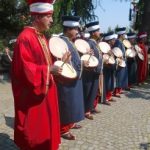Population: 10,000
Old names: Proikonesos, Procennesus
Marmara Island (Marmara Adası) is the second largest island in Turkey after Gökçeada. It may be the prettiest of the Marmara Islands in the southern Sea of Marmara but that hardly makes it Büyükada even in a metaphorical sense. Forget images of lovely wooden houses and phaetons clip-clopping through the forest. Banish, too, any fantasies of pristine Aegean loveliness, all whitewashed walls and drooping bougainvillea. Instead think something more like Bakırköy-on-Sea and imagine an island whose prettyish harbour is backed with a wall of small apartment blocks and whose centrepiece is a branch of Bim.
No great beauty, then. Not much in the way of specific attractions either, although there is a small market selling locally-dried herbs, seashells and lots of sardine conserve in olive oil.
Nevertheless as soon as you step off the seabus there is that wonderful, liberating sense of arriving on an island. The air feels clear. There’s no traffic noise. There are plentiful cafes lined up on the waterfront, each of them in the shade of a giant plane tree and each of them the sort of place where you can find a lot of time slipping away from you if you’re not careful.
What people come here for is the beaches. There are small sand and shingle beaches on the outskirts of Marmara “town” and a much nicer stretch of sand round at Çınarlı (once Galemi) where notices tacked onto the enormous plane trees suggest that several are more than 1,000 years old.
At Çınarlı you will find slender young women in tiny tops rubbing shoulders on the beach with portly matrons in full Islamic swimming costumes that look like colourful wetsuits. Here there are several sweet little pensions which face directly onto the sands, as well as a string of cafes dispensing the food a holidaying Turk is likely to fancy – köfte, piyaz, pide, stuffed mussels, simits and, more unexpectedly, hoşmerim, a helva-like dessert.
This is not a place to come if history’s your thing. Even down the Marmara back streets you’ll be struggling to find traces of the past, beyond the odd marble cartouche identifying a long-lost church and a couple of old marble fountains. Only the Marmara Lisesi (high school) and Hükümet Konağı (government building) are fine stone buildings erected at a time before people thought that a mosque that looked as if it had been designed and built by children would make a great addition to the skyline.
At one time there must have been a sizeable and wealthy Ottoman community here to judge by some of the Eyup-style gravestones standing neglected in the island’s small cemetery. However, with the exception of one staggeringly beautiful old Ottoman house facing out to sea near Manastir it seems to have vanished without trace.
Things don’t get going in Marmara Town until well after 10 o’clock at night which is when the fish restaurants start to fill up and when the live music kicks off in the bars. At midnight people are still promenading up and the down the main street licking ice-creams – don’t count on an early night, especially over the weekend.
White Proconnesian marble was and still is the island’s main export and crops up all over the country including inside Ayasofya Cami in İstanbul.
Backstory
On the northern shore of Marmara Island the settlement of Saraylar (Palaces, once Palatia) faintly recalls a time when the Emperor Justinian had a palace built for himself here, inspiring an entire entourage of officials to do the same. The island continued to be occupied almost entirely by Greeks until the 17th century when they were joined by some Jews. But during the First World War most of them were forced to vacate the island and following the terms of the Treaty of Lausanne they then had to leave the country, settling in Neos Marmaras on the Halkidiki peninsula. Their place was taken by Turks from Greece and Circassians from the Caucasus.
Sleeping
Dostlar Pension, Çınarlı. Tel: 0266-895 8130
Gül Pension, Çınarlı Tel: 0266-895 8011)
Boncuk Motel, Marmara Town Tel: 026-885 5055
Otel Nergis, Kalınburun Tel: 0266-885 5577
Transport info
İDO (Tel: 444 4436) runs seabuses to Avşa via Marmara from Bostancı and Yenikapı in Istanbul.
There are also slower ferries from Sarayburnu in İstanbul, and more possibilities from Tekirdağ in Thrace.
